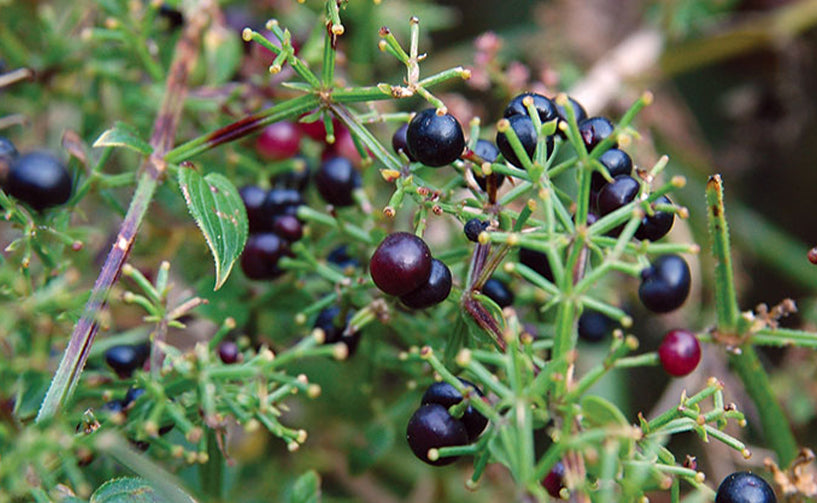Manjistha or Rubia Cordifolia, also known as Indian madder belongs to coffee or the Rubiaceae family. It is found all over India at high altitudes and hilly areas like Himalayan region, Darjeeling etc. Besides Asia, it also grows in the hilly region of France, U.S.A., Europe, Egypt and Netherlands. It is grown to harvest the red pigment from the roots apart from use in medicines and supplements. Manjistha is the Sanskrit name of Rubia Cordifolia.
It is a small shrub which grows up to 1 meter in height with evergreen leaves and small yellow flowers which grow into black or red berries. It grows as a climber. Manjistha is a rejuvenating and detoxifying herb whose roots have a cooling effect and are bitter in taste.
An organic compound known as “Alizarin” which is extracted from the roots of Rubia Cordifolia is an important natural red pigment or dye for the textile industry. Manjistha is used to dye wool, silk, cotton fabrics, carpets, blankets, linen and baskets to impart different shades and colours. It is also used as paint and known as rose madder. Manjistha has also been used in Tibetan medicine system to remove excess heat from the body and also used to treat swelling, kidney, intestines and lung disorders.
Traditionally in Ayurveda, the roots of this plant were used to treat bronchitis, kidney and gallbladder stones, haemorrhage, uterine bleeding, skin infections, diarrhoea, dysentery etc.
Natural Constituents of Manjistha
The roots are loaded with glycosides (approximately 20) and anthraquinones, so the major phyto-constituents are munjistin, purpurin, alizarin, pseudopurpurin, mollugin, furomollugin, garacin and many more. Aborane, triterpinoids, carbo-oxy anthraquinones, 2-hydroxy -6-methyl anthraquinones 2, 6-dihydroxy anthraquinones and the rubiasins A, B, C are also found in this plant.
All these phytochemicals provide strong anti-inflammatory, anti-oxidant, expectorant, anti-dysenteric, analgesic, anti-pyretic (fever reducing), anthelmintic, anti-tumour, diuretic, immunomodulatory, anti-convulsant, anti-viral and anti-bacterial properties to the herb.
Benefits of Manjistha
Astringent and bitter R. cordifolia is a valuable and effective herb to cleanse the blood and the lymphatic system. It clears the way for better cell nutrition and removes harmful toxins from the body. It is a powerful antibacterial, antioxidant and anti-inflammatory and used to relax muscles, relieve stress and depression. Since it helps to control agitated nerves, it is one of the more valuable calming and cooling herbs.
Other benefits:
Other benefits:
-
Gastrointestinal disorders: such as dyspepsia, loss of appetite and expelling worms.
-
Helps in Managing Diabetes: It acts as a blood purifier and is hepatoprotective which means it protects the liver.
-
Benefits to Skin: It treats ailments such as eczema, skin allergies, scabies, itching, age spots,acne, pimples, hyper pigmentation or melasma, freckles, discoloration and psoriasis.
- Works to reduce urinary infections and varicose veins.
- Manjistha helps in reducing the pain associated with Rheumatism and joint inflammation. As it contains salicylates and triterpenoids.
- Help in healing boils, burns, bone fractures and ulcers. It reduces calcium deficiency in the body.
- Useful in managing fever and respiratory related ailments.
- Provides relief in ailments affecting women such as irregular menstruation, amenorrhea, oligomenorrhea and other fungal infections. It also stops excessive uterine bleeding thus preventing miscarriage as well.
- Helps to fight both benign and malignant tumours.
- It is a blood purifying agent and helps in detoxifying the whole body.
- The seeds, leaves and the roots can be used in spleen, kidney, liver and gall bladder disorders.
- It is a very useful antidote for poisonous snakes and scorpion bites.
Manjistha and Safety: If consumed in excess, it may cause constipation, may worsen blood and digestion related ailments and may cause temporary restlessness.






